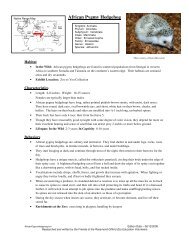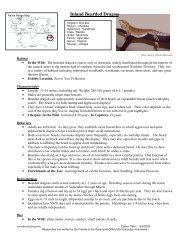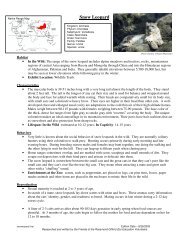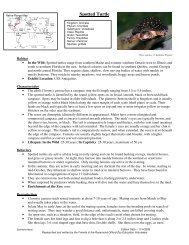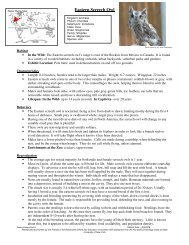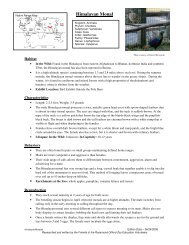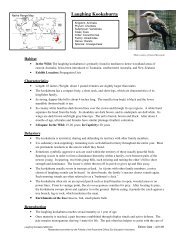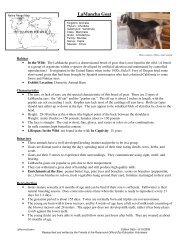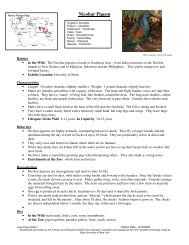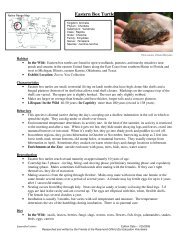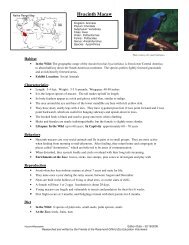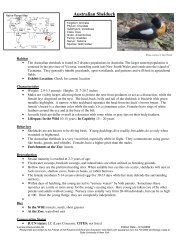Madagascar Hissing Cockroach - Rosamond Gifford Zoo
Madagascar Hissing Cockroach - Rosamond Gifford Zoo
Madagascar Hissing Cockroach - Rosamond Gifford Zoo
You also want an ePaper? Increase the reach of your titles
YUMPU automatically turns print PDFs into web optimized ePapers that Google loves.
<strong>Madagascar</strong> <strong>Hissing</strong> <strong>Cockroach</strong><br />
Kingdom: Animalia<br />
Phylum: Arthropoda<br />
Subphylum: Uniramia<br />
Class: Insecta<br />
Order: Blattaria<br />
Family: Blattidae<br />
Genus: Gromphodorhina<br />
Species: portentosa<br />
<strong>Hissing</strong><strong>Cockroach</strong>sm Edition Date – 1/25/2006<br />
Researched and written by the Friends of the <strong>Rosamond</strong> <strong>Gifford</strong> <strong>Zoo</strong> Education Volunteers<br />
Photo courtesy of Karen Marzynski<br />
Habitat<br />
• In the Wild: This species of cockroach is found in leaf litter on the forest floor only in <strong>Madagascar</strong>.<br />
• Exhibit Location: USS Antiquities, <strong>Zoo</strong> to You Collection<br />
Characteristics<br />
• The <strong>Madagascar</strong> hissing cockroach is wingless and can reach a length of 2-3 inches.<br />
• They have grasshopper-like mouthparts designed for chewing. They also have special adhesive pads on<br />
their feet and forelegs to help them move over slick surfaces.<br />
• Males are distinguished by prominent bumps or horns behind their heads, which they use as battering<br />
rams in territorial and courtship shoving matches, jockeying for position. Females lack these horns.<br />
• Lifespan: In the Wild Unknown; In Captivity 2-5 years<br />
Behaviors<br />
• <strong>Madagascar</strong> hissing cockroaches are nocturnal and semi-communal. They are not aggressive to other<br />
species and are too slow to escape most predators.<br />
• Males are territorial and have a hierarchy, but they are not social like ants. They are aggressive towards<br />
each other but not towards females or nymphs (young).<br />
• They produce a snake-like hissing that startles predators. When disturbed, the entire colony hisses<br />
together for a really disturbing sound. There are at least 5 types of hisses: a male combat hiss, 2 types of<br />
courting and 1 mating hiss, and an alarm hiss.<br />
• Dominant males show off by standing on their toes (called stilting). Male combat involves ramming each<br />
other with their horns, using their abdomens to flick, push or thrash, hissing the whole while. The male<br />
that is larger and hisses more usually wins.<br />
• Forcing air through spiracles on the abdomen does the hissing. Air sacs work like bellows and squeeze<br />
out the air. They are the only insects to make sounds this way.<br />
• Enrichments at the <strong>Zoo</strong>: rearranging exhibit furniture (branches, leaves and other objects that simulate<br />
their natural habitat)<br />
Reproduction<br />
• Sexual maturity is reached at 7 months of age.<br />
• During courtship, the pair strokes each other’s antennae, then their bodies, while hissing sweet nothings<br />
to each other. Females can tell the rank of males and will prefer to mate with the dominant male.<br />
• The gestation period is 2 months. The female produces 20-60 nymphs. In one lifetime, a female can<br />
breed 30 times, producing more than 750 babies.<br />
• The mother appears to give birth to live young, but they actually come from eggs in a capsule inside her<br />
abdomen. She retains the capsule until the eggs hatch, and then she eats it. The nymphs remain grouped<br />
around her while she protects them by raising her body over them. The nymphs mature in 5-10 months<br />
and leave the mother.<br />
Diet<br />
• In the Wild: decaying fruit, vegetable matter, other insects (speed up the process of decomposition by<br />
eating dead and decaying plants)
• At the <strong>Zoo</strong>: fruits, vegetables, monkey biscuit<br />
Conservation Status<br />
• IUCN status: not listed; CITES Appendix: not listed<br />
• This species of cockroach is common in <strong>Madagascar</strong> and is restricted only to that island.<br />
• Predators: birds, mammals<br />
Did You Know/Fun Facts<br />
• They are an important source of food for other animals. Insects have 3 times more protein than chicken<br />
or beef, weight for weight.<br />
• <strong>Madagascar</strong> hissing cockroaches have recently become a common pet. They make ideal teaching insects<br />
because they don’t bite, don’t fly, and are generally odorless and not very active.<br />
Sources:<br />
• Gordon, D. (1996). The complete cockroach. Berkeley, CA: Ten Speed Press.<br />
• Singapore <strong>Zoo</strong>, (n.d.). <strong>Madagascar</strong> giant hissing cockroach. Retrieved Oct. 22, 2005, from Singapore <strong>Zoo</strong><br />
Web site: http://www.szgdocent.org/resource/ff/f-bhiss.htm.<br />
<strong>Hissing</strong><strong>Cockroach</strong>sm Edition Date – 1/25/2006<br />
Researched and written by the Friends of the <strong>Rosamond</strong> <strong>Gifford</strong> <strong>Zoo</strong> Education Volunteers



